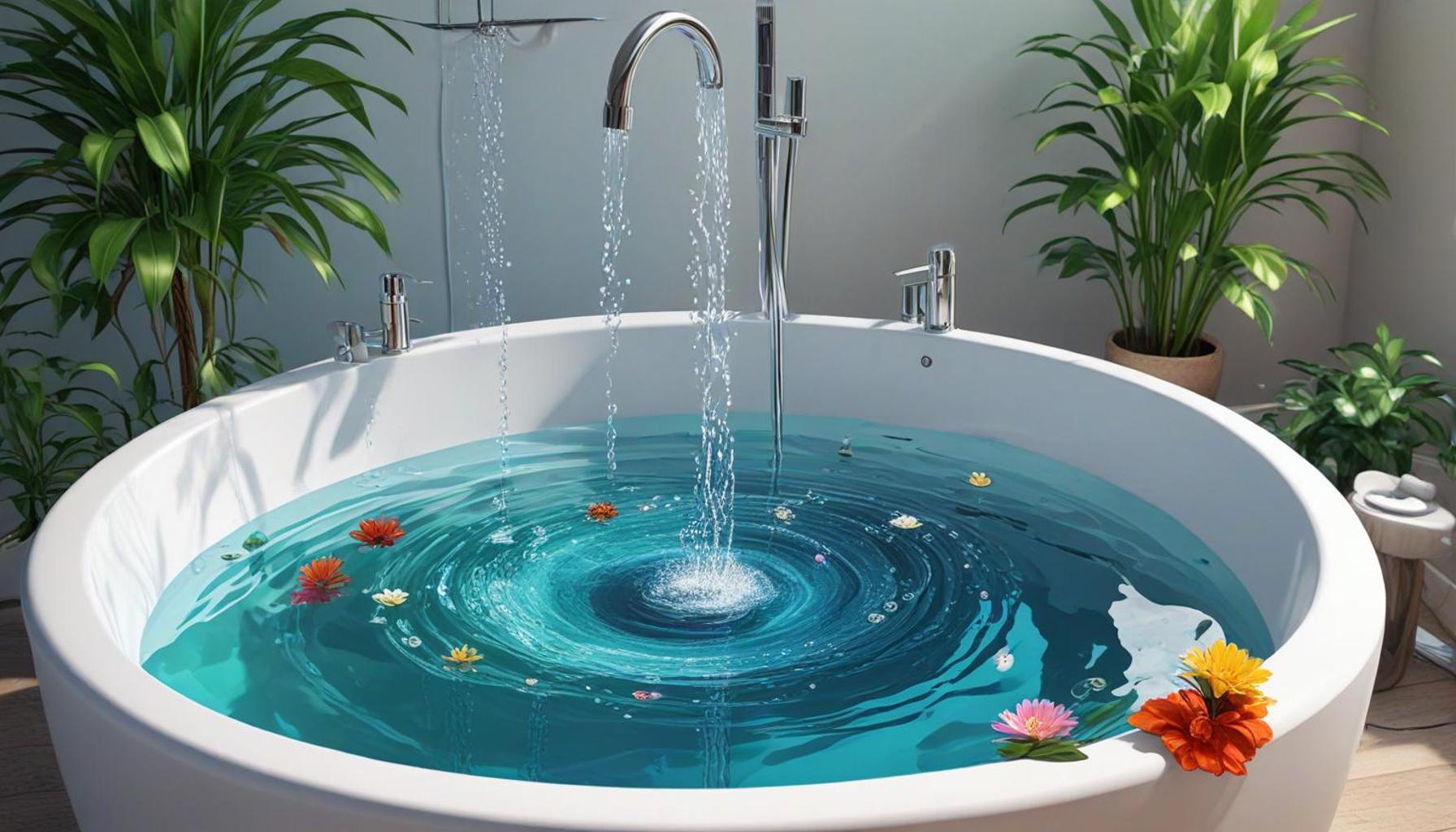Sounds of Water: Incorporating the Sound Element in Guided Visualization of Bathing Meditation

Diving Deeper into Meditation with Water Sounds
The gentle sounds of water have captivated our senses for centuries, fostering a sense of tranquility that is hard to replicate. In the realm of meditation, these natural auditory cues are not just background noise; they play a crucial role in enhancing the overall meditative experience. Whether through the gentle trickle of a stream or the rhythmic crashing of ocean waves, water sounds can elevate mindfulness and promote a profound sense of peace.
Consider the transformative power of various water sounds in your meditation practice:
- Rushing streams – the dynamic quality of flowing water often symbolizes renewal and clarity. As you visualize a stream, it can stimulate thoughts of cleansing your mind from negative energies, leading to a refreshed perspective.
- Soft rain – the delicate patter of raindrops can promote introspection and contemplation. Listening to rain encourages a deeper exploration of your thoughts and emotions, fostering a serene atmosphere conducive to self-reflection.
- Ocean waves – the vastness of the sea has a way of instilling a sense of freedom and expansiveness. As the waves rise and fall, they mimic the ebb and flow of life itself, reminding practitioners to embrace the present moment with an open heart.
- Warm baths – this element combines physical sensation with auditory relief. The sound of water enveloping you while submerged creates a multisensory experience that deeply resonates with the body and mind.
For individuals in Nigeria, the local environment offers a rich tapestry of unique water sounds that can enhance meditation practices. Imagine the soothing sounds of the Niger River as it meanders through lush greenery or the rhythmic drumming of rainfall common during the wet season. Incorporating these local sounds into your meditative journey can create a deeply personal experience, allowing you to connect with your surroundings on a new level.
Furthermore, utilizing these layered soundscapes can lead to deeper states of relaxation. Engaging in guided visualization with water sounds can encourage a higher level of focus and presence. Visualization techniques may include picturing yourself sitting beside a tranquil stream or meditating on the shore of a beautiful beach, embodying the energies each sound represents.
As we explore the integration of water sounds into meditation, we uncover effective methods to utilize sound elements in enhancing well-being. By embracing the tranquility found in the sounds of water, individuals can embark on a transformative journey toward greater mental well-being and heightened self-awareness.
CHECK OUT: Click here to explore more
Embracing the Rhythms of Water in Meditation
Incorporating the sounds of water into your meditation practice can be a transformative experience, providing not just a backdrop but a pivotal element that immerses you fully in the moment. The auditory richness of water, from the soft rustle of leaves brushing against a flowing river to the sonorous whispers of waves crashing against rocks, creates an enchanting atmosphere that enhances the effects of meditation. Understanding how to utilize these sounds effectively can enhance your mindfulness practice and deepen your connection with the present.
When you immerse yourself in the auditory landscape of water, consider how it resonates with different aspects of your being:
- Therapeutic qualities – The sound of water has been shown to have calming effects on the mind and body. Research indicates that listening to natural water sounds can lower stress levels and prompt feelings of relaxation, enhancing one’s ability to meditate.
- Symbolism of water – Water is a universal symbol of life, healing, and emotional refreshment. It represents an infinite cycle of rebirth and renewal, and when included in meditation, can facilitate personal transformation.
- Spiritual enhancement – For many cultures, water holds spiritual significance. In Nigerian traditions, rivers are often seen as life-giving forces. Tap into this rich heritage by using local water sounds in your meditation, connecting with ancestral wisdom and the rhythms of life.
- Focus and clarity – The rhythmic patterns of water sounds can help anchor your attention. Much like a mantra, the consistent flow of water can guide your thoughts back to the present moment, creating a fertile ground for deeper meditation.
To effectively incorporate water sounds into your guided visualization practice, begin by creating a serene environment. Choose a space free from distractions and incorporate water sounds through recordings or natural sources, if available. As you settle in, focus on your breath as you visualize a calming scene—a babbling brook, a gentle rainfall, or the embrace of ocean waves.
This visualization not only allows you to enjoy the sensory experience of the sounds but also invites you to create a narrative around them. Imagine the sensation of warm water enveloping you, washing away worries and negativity. Consider how this visualization can lead to profound emotional healing, making it a unique and deeply personal journey.
For many in Nigeria, the local water bodies such as the Niger River or the beautiful beaches of the Atlantic coast stand as testaments to the beauty of water. By embracing these familiar sounds, you can create a meditation practice that resonates deeply with your cultural identity, enriching the experience further.
As you explore this connection between meditation and the sounds of water, you are not just engaging in a practice; you are embarking on a quest for healing, clarity, and self-discovery. This journey can lead you to greater mental well-being and a deeper understanding of your own life’s currents.
In exploring the theme of “Sounds of Water: Incorporating the Sound Element in Guided Visualization of Bathing Meditation,” one can delve deeper into the multifaceted benefits that this approach offers. Utilizing the soothing sounds of water can significantly enhance the meditative experience, providing practitioners with a sense of tranquility and connection to nature. The auditory presence of water—whether it be the gentle trickling of a stream, the rhythmic crashing of ocean waves, or a soft rainfall—serves as a bridge to mindfulness, allowing individuals to immerse themselves fully in the meditation process.Furthermore, research indicates that these natural sounds can activate specific areas of the brain associated with relaxation and emotional well-being. As individuals engage in bathing meditations complemented by the harmonious sounds of water, they can experience reduced stress and anxiety levels, leading to more profound states of relaxation. This form of guided visualization not only helps in clearing the mind but also promotes an emotional release, making it an invaluable tool for those dealing with the pressures of daily life.Sensory engagement is vital in enhancing the meditative experience. The sound of water can evoke memories and feelings of safety, comfort, and peace, creating a sacred space for introspection. As individuals visualize being enveloped in water, they can channel their energies towards self-healing and personal growth. Incorporating the sound element can also facilitate deeper breathing patterns, further assisting in achieving a meditative state. In sum, the interplay between the sound of water and guided visualization enriches the meditation experience, making it a journey that not only soothes the mind but also rejuvenates the soul. This innovative approach paves the way for a more holistic healing practice, which encourages individuals to seek connection with themselves and the world around them.
| Advantage | Description |
|---|---|
| Enhanced Relaxation | The calming effects of water sounds promote mental and emotional tranquility. |
| Connection to Nature | Integrating water sounds allows for a deeper connection and grounding with natural elements. |
This comprehensive examination of the sound element in guided visualization emphasizes its transformative potential in meditation practice. By embracing these auditory tools, practitioners can craft uniquely personal experiences that nurture both body and spirit, ultimately leading to greater overall well-being.
ADDITIONAL INSIGHTS: Expand your understanding here
Exploring Techniques for Water Sound Integration
To deepen your meditation practice, it is essential to explore various techniques for effectively integrating water sounds into your guided visualization sessions. Each approach can offer a unique experience, allowing you to tailor your practice to your preferences and enhance your connection to the essence of water.
One effective method is to synchronize your breathing with the sound patterns of water. As you settle into your meditation, listen intently to the gentle ebb and flow of a stream or the rhythmic laps of ocean waves. You might envision each inhalation filling you with the vitality of the water, while each exhalation releases tension and negativity. This synchronization creates a sense of harmony with the surrounding soundscape, inviting deeper mindfulness and awareness.
Another intriguing technique involves layering sounds. Consider combining multiple water sound recordings, such as the chirping of crickets by a pond or the soft rumble of distant thunder accompanying raindrops. Layering these sounds can create a rich tapestry that immerses you fully into the natural world. For instance, visualizing the water cycle—how rain nourishes the earth, flows into rivers, and eventually rejoins the vast ocean—can help ground your experience in a larger narrative of existence. This synthesis not only evokes tranquility but also offers a profound appreciation for the interconnectedness of life.
The local waterways in Nigeria provide numerous inspirations for guided visualization. The melodious sound of the Niger River can serve as a backdrop, allowing you to imagine yourself drifting peacefully along its banks, perhaps interacting with local flora and fauna that thrive in that environment. Picture the shimmering surface, sunlight reflecting off the water, inviting peace and serenity. Such vivid imagery, rooted in familiar sounds, can transform your meditation from a personal practice into a communal experience, connecting you with shared cultural heritage.
Incorporating visual cues can further enhance your meditation. Create a scene in your mind where you immerse yourself in water, perhaps visualizing a serene bath in an outdoor spring. As you hear the water’s gentle trickle, imagine its coolness enveloping you, washing away stress and rejuvenating your spirit. Utilizing visualization in this way can deepen your emotional release and facilitate healing, as you actively engage with the therapeutic qualities associated with water.
As you experiment with these techniques, consider incorporating mindful rituals that reflect the importance of water in your life. For instance, you might start or end your meditation by pouring a small bowl of water over your hands, connecting with the cleansing properties of water physically. This simple act can ground your practice in tangible sensory experience, allowing for a spiritual connection to the water element that permeates much of Nigerian life, from its rivers to its sacred springs.
By continually exploring and integrating water sounds and visualizations into your meditation, you create a dynamic practice that evolves alongside your journey of self-discovery. The interplay between sound and imagery facilitates a profound connection with both your inner reality and the world around you, enhancing the significance of each meditation session.
LEARN MORE: This related article may interest you
Embracing the Healing Power of Water Sounds
In conclusion, the integration of water sounds into guided visualization for bathing meditation offers an enriching path for enhancing mindfulness, relaxation, and emotional healing. As we embrace the soothing melodies of nature, particularly those found within the vibrant waterways of Nigeria, we can cultivate a deeper sense of tranquility and connection to our surroundings. The gentle trickle of a stream, the rhythmic crash of waves, or even the raucous dance of rain can transform a simple meditation into a tapestry of experiences, immersing us in a cultural and personal narrative.
By employing techniques such as breath synchronization and sound layering, practitioners can tailor their meditative experiences to suit their emotional needs and preferences. This personalization promotes an atmosphere of serenity and invites a harmonious relationship with the essence of water—a symbol of life and regeneration. Additionally, incorporating mindful rituals related to water can further enhance this practice, forging a tangible connection to the cleansing and nurturing properties inherent in this vital element.
As you delve into these explorations, consider how the sounds of water can not only ground your practice but also serve as a reminder of the importance of community and shared experiences in the context of nature. The healing power of water can be a guiding force, inviting meditation practitioners to reflect not only on their inner landscapes but also on the broader ecological narratives that connect us all. By continuing to incorporate the sound element in your bathing meditations, you’re not simply engaging with a practice; you’re embarking on a journey towards self-discovery and deeper appreciation for the vibrant world around you.


